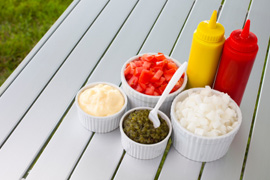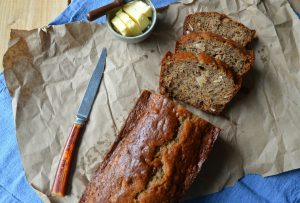Killer Condiment Conundrum

It’s barbecue season and what could be faster, tastier and healthier than a little something grilled? From tofu and veggies, to burgers and dogs, anything on a bun is beloved by our backyard and cottage culture. You carefully choose the leanest meat and whole grain bun, but what you top it with could be a slather of unsuspecting empty calories. Here is your condiment guide in order of worst to best: choose wisely and slip back into your skinny jeans come the fall. Heed not and risk looking like the sausage yourself.
Worst to Best Burger Toppers
Mayonnaise (or anything made with mayonnaise)
All commercial mayos are made by thickening some kind of liquid fat into a solid. Either the traditional whipping of oil into eggs is used, or the lower fat treatment of using a corn or seaweed derived thickener, the concept is still the same: fat. Delicious, creamy fat that will cost you about 100 calories per tablespoon, no matter which brand you buy. Tartar sauces and ‘sandwich spreads’ are no better; they deliver no nutrients and too many calories. If you simply must have your mayo, opt for President’s Choice Blue Menu mayo or Hellmann’s Half the Fat because either will cut your calories down to half. Heed this, though, even then, they are more caloric than the next worst spoonful. (Yogurt makes for a decent substitute.)
Barbecue Sauce
This bold bounce to your bun packs a punch, but most formulations begin with sugar and water. Mixing in a proprietary blend of tomato sauce and spices makes each version a flavour all its own and everyone has their favourite. Offering almost no nutritional value for its 300–400 mg of sodium (almost 1/3 of a healthy day’s dose) in one tablespoon is a crime before you even consider the 30–40 calories. There is one on the shelf that provides the taste without all the calories, and that’s Kraft Calorie Wise at a decent 10 calories per tablespoon. It uses more water and corn-thickeners to reduce the load but keep the consistency. You don’t get a break on the salt, though.
Ketchup
Treasured by children and loved by all as the condiment of choice for just about everything, ketchup takes the middle spot for the fact that it relies upon one of earth’s healthiest vegetables. Albeit, this is a high-salt, high-sugar way to get that vegetable, but still. Most formulations do start with tomatoes or tomato paste that is thinned down with vinegar and water and seasoned up with salt, spices and sugar. The top few brands weigh in at about 20–25 calories per tablespoon delivering about 10–15 % of your healthy day’s amount of salt. The No Name brand is a little lower, though the formulation looks about the same, so expect it to be a little thinner (higher in water). Heinz has a low-sodium version that will save about half the sodium and PC Blue Menu has one that uses sucralose to reduce the sugar (and that has its downsides too!). Even with the ‘improvements’, this red spoonful is still middling at best.
Relish
Now we are moving to the better side of the bun. Not all relish is created equal; you can still stumble if you choose sweet green, zucchini or chili. All offer little nutritional benefit and about 15–25 calories per tablespoon, which is about the same as ketchup. But there is a rising star here that can deliver huge taste for a mere four calories per tablespoon: Bick’s Dill Relish is the pick of pack. It does dose with the same kind of sodium found above, but for much fewer calories in the end.
Mustard – Best in Class!
All you have to do is avoid the honey mustards and mustard blends and you can’t go wrong. Each and every mustard on the shelf is lower in calories than anything else you are going to squeeze on your dog. And they are little superheroes packing much more than they seem—made from mustard seed, which is a high antioxidant spice that has anti-inflammatory properties. If it is colored at all, it is usually with trace amounts of turmeric which is another potent anti-cancer spice. Rarely made with sugar (thus the ‘avoid the honeyed versions’ note) and only mixed with vinegar, and very little salt, it offers a zing for a caloric pittance. There are some outstanding gourmet formulations on the market that are truly worth trying, but even the cheapest brand of yellow ballpark mustard is worth adding.















